
Somerville is a city located directly to the northwest of Boston, and north of Cambridge, in Middlesex County, Massachusetts, United States. As of 2019, the United States Census estimated the city to have a total population of 81,360 people. With an area of 4.11 square miles, the city has a density of 19,893 people per square mile, making it the most densely populated municipality in New England, and the 16th most densely populated incorporated municipality in the country. Somerville was established as a town in 1842, when it was separated from Charlestown. In 2006, the city was named the best-run city in Massachusetts by the Boston Globe. In 1972, in 2009, and again in 2015, the city received the All-America City Award. It is home to Tufts University, which has its campus along the Somerville and Medford border.
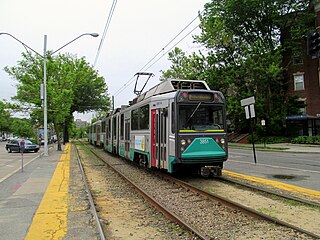
The Green Line is a light rail system run by the Massachusetts Bay Transportation Authority (MBTA) in the Boston, Massachusetts, metropolitan area. It is the oldest Boston rapid transit line, and with tunnel sections dating from 1897, the oldest in America. It runs as a deep-level subway through downtown Boston, and on the surface into inner suburbs via four branches on several radial boulevards. With an average daily weekday ridership of 152,200 in 2019, it is the second most heavily used light rail system in the country. The line was assigned the green color in 1967 during a systemwide rebranding because several branches pass through sections of the Emerald Necklace of Boston.

The Orange Line is one of the four subway lines of the Massachusetts Bay Transportation Authority. It extends from Forest Hills in Jamaica Plain, Boston in the south to Oak Grove in Malden in the north. It meets the Red Line at Downtown Crossing, the Blue Line at State, and the Green Line at Haymarket and North Station. It connects with Amtrak service at Back Bay and North Station, and with MBTA Commuter Rail service at Back Bay, North Station, Forest Hills, Ruggles station in Roxbury, and Malden Center in Malden. From 1901 to 1987, it provided the first elevated rapid transit in Boston; the last elevated section was torn down in 1987 when the southern portion of the line was moved to the Southwest Corridor.

Alewife station is an Massachusetts Bay Transportation Authority (MBTA) intermodal transit station in the North Cambridge neighborhood of Cambridge, Massachusetts. It is the northwest terminal of the rapid transit Red Line and a hub for several MBTA bus routes. The station is located off Alewife Brook Parkway adjacent to the eastern end of the freeway portion of Massachusetts Route 2, with a five-story parking garage for park and ride use. Located at the confluence of the Minuteman Bikeway, Alewife Linear Park, Fitchburg Cutoff Path, and Alewife Greenway, the station has three bike cages. Alewife station is named after nearby Alewife Brook Parkway and Alewife Brook, wthemselves named after the alewife fish.
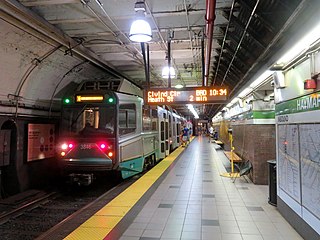
Haymarket is a subway station in Boston, Massachusetts. It serves the MBTA's Green and Orange lines, and is located at the corner of Congress and New Sudbury streets in Downtown Boston. Haymarket allows transfers between the Orange and Green lines, as does North Station one stop to the north. Haymarket was named for Haymarket Square, which has served as a produce market since around 1830.

Wellington is a rapid transit station in Medford, Massachusetts. It serves the MBTA's Orange Line. It is located on the Revere Beach Parkway, slightly east of its intersection with Route 28. Wellington functions as a park and ride with more than 1,300 spaces, and a bus hub with 10 routes terminating at the station. The Station Landing development, connected to the station by an overhead walkway, includes residential and retail buildings and additional parking.

Lechmere station is a light rail station in Lechmere Square in East Cambridge, Massachusetts, near the intersection of Cambridge Street and Monsignor O'Brien Highway. An elevated station is under construction nearby as part of the Green Line Extension, replacing for the former surface-level station, which closed on May 24, 2020. The bus terminal at the old station remains open as a transfer point between MBTA bus routes and Lechmere–North Station shuttle buses until the new station opens. The new station will be served by the D Branch and E Branch of the MBTA Green Line upon its planned April 2021 opening.

Malden Center is an intermodal transit station in Malden, Massachusetts. Located on an elevated grade above Pleasant Street in downtown Malden, it serves the MBTA's rapid transit Orange Line and the MBTA Commuter Rail Haverhill Line, as well as 13 MBTA bus routes. The current station opened on December 27, 1975, replacing an older brick station which has since been repurposed as a restaurant.

The Atlantic Avenue Elevated was an elevated railway around the east side of Downtown Boston, Massachusetts, providing a second route for the Boston Elevated Railway's Main Line Elevated around the Washington Street tunnel. It was in use from 1901 to 1938, when it was closed due to low ridership, later being demolished.
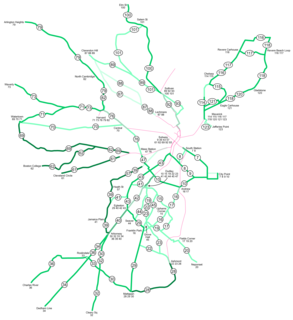
As with many large cities, a large number of Boston-area streetcar lines once existed. However, only a few remain, namely the four branches of the Green Line and the Ashmont–Mattapan High-Speed Line, with only one running regular service on an undivided street.

Sullivan Square is a rapid transit station in Boston, Massachusetts. It serves the MBTA's Orange Line, and is also a major bus transfer point. It is located just west of the Sullivan Square traffic circle in the Charlestown neighborhood, adjacent to East Somerville. The modern subway station was built in 1975, and replaced an earlier Charlestown Elevated station established in 1901.
The Urban Ring was a proposed project of the Massachusetts Bay Transportation Authority and the Massachusetts Department of Transportation, to develop new public transportation routes that would provide improved circumferential connections among many existing transit lines that project radially from downtown Boston. The Urban Ring Corridor is located roughly one to two miles from downtown Boston, passing through the Massachusetts cities of Boston, Chelsea, Everett, Medford, Somerville, Cambridge, and Brookline. The project was expected to convert 41,500 car trips to transit trips daily.

Community College is a rapid transit station on the MBTA Orange Line in Boston, Massachusetts. It is located in the Charlestown neighborhood off Austin Street near New Rutherford Avenue (MA-99), under the double-decked elevated structure carrying Interstate 93 to the Zakim Bunker Hill Bridge. The station is named for the adjacent Bunker Hill Community College. Like all Orange Line stations, Community College station is fully accessible.
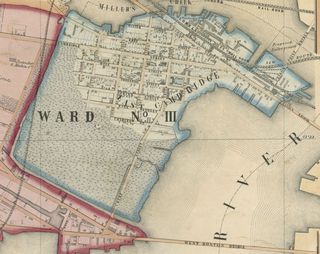
East Cambridge is a neighborhood of Cambridge, Massachusetts. Referred to in modern times as Area 1, East Cambridge is bounded by the Charles River and the Charlestown neighborhood of Boston on the east, the Somerville border on the north, Broadway and Main Street on the south, and the railroad tracks on the west. Most of the streets form a grid aligned with Cambridge Street, which was laid out to directly connect what is now the Charles River Dam Bridge with what in 1809 was the heart of Cambridge, Harvard Square. The northern part of the grid is a roughly six by eight block residential area. Cambridge Street itself is retail commercial, along with Monsignor O'Brien Highway, the Twin Cities Plaza strip mall, and the enclosed Cambridgeside Galleria. Lechmere Square is the transportation hub for the northern side. The southern half of the grid is largely office and laboratory space for hundreds of dot-com companies, research labs and startups associated with MIT, biotechnology firms including Genzyme and Biogen, the Athenaeum Press Building, light industry, an NRG Energy power station, and various small businesses. This half of the neighborhood is generally identified with Kendall Square. Along the waterfront are several hotels and taller apartment buildings.
The Haymarket North Extension is a section of the Massachusetts Bay Transportation Authority's rapid transit Orange Line which currently constitutes the northern section of the line. It runs from North Station through an underground crossing of the Charles River, then along the Haverhill Line right-of-way to Oak Grove station in Malden, Massachusetts. Built to replace the Charlestown Elevated and originally intended to be extended as far as Reading, it opened in stages between 1975 and 1977.

The Green Line Extension is an initiative to expand transit services in Greater Boston by extending the Massachusetts Bay Transportation Authority (MBTA) Green Line light rail beyond its current northern terminus at Lechmere in Cambridge, Massachusetts. The 4.3-mile (6.9 km) extension is intended to improve mobility and regional access for residents in the densely populated municipalities of Somerville and Medford, two cities currently underserved by the MBTA relative to their population densities, commercial importance, and proximity to Boston.
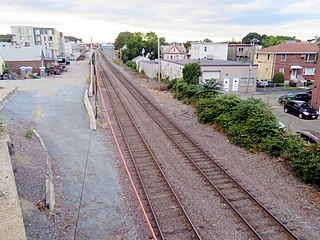
Ball Square is a planned station on the MBTA Green Line D branch in the Ball Square neighborhood of Somerville, Massachusetts. Ball Square will consist of one island platform, which will serve the D branch's two tracks.

Gilman Square is a planned light rail station on the Massachusetts Bay Transportation Authority (MBTA) Green Line in Somerville, Massachusetts, planned to be constructed on the Medford branch of the Green Line Extension. Gilman Square will consist of one island platform, which will serve the two proposed tracks. It is projected to open in 2021.

East Somerville is a neighborhood in the eastern part of the city of Somerville, Massachusetts. The community stretches east along Broadway from Massachusetts Route 28 to Sullivan Square and Interstate 93 on the city line with the Boston neighborhood of Charlestown.

North Station is an underground MBTA subway station in Boston, Massachusetts. Served by the Massachusetts Bay Transit Authority (MBTA) Green Line and Orange Line, it is connected to the North Station surface terminal used by MBTA Commuter Rail and Amtrak. The station is fully accessible. From May 24, 2020, to April 2021, North Station is temporarily the northern terminus of Green Line service due to Green Line Extension construction.



















